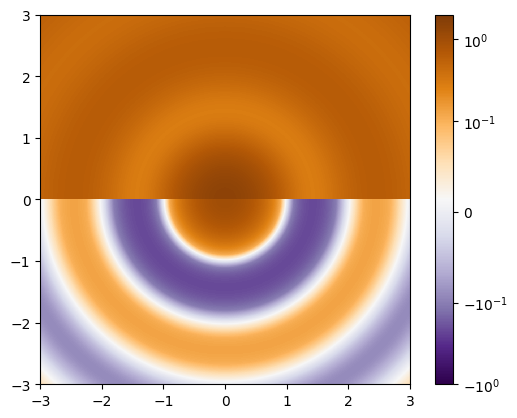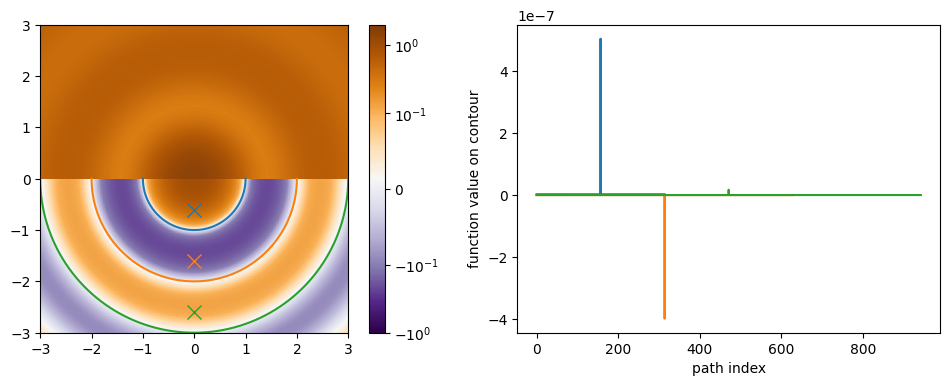Example 2, discontinuous function
For our second example we will look at a discontinuous function with zero contours that terminate in end points. We will use jax.numpy.where to add in the discontinuity, as a result we need to make sure forward_mode_differentiation is specified when we use the value_and_grad_wrapper.
%load_ext autoreload
%autoreload 2
import jax
import jax.numpy as jnp
jax.config.update("jax_enable_x64", True)
import matplotlib.pyplot as plt
import matplotlib.colors as colors
from jax_zero_contour import ZeroSolver
@jax.tree_util.Partial
def f(pos):
# avoid r=0 so the grad is finite
r = jnp.sqrt(jnp.sum(pos**2, axis=0) + 1e-15)
theta = jnp.arctan2(pos[1], pos[0])
z = jnp.sinc(r)
return jnp.where(theta >= 0, z + 0.5, z)
n = 1024
x = jnp.linspace(-3, 3, n)
y = jnp.linspace(-3, 3, n)
X, Y = jnp.meshgrid(x, y)
z = f(jnp.stack([X, Y]))
plt.imshow(
z,
extent=(x.min(), x.max(), y.min(), y.max()),
norm=colors.SymLogNorm(linthresh=0.1, vmin=-1, vmax=2),
cmap='PuOr_r',
origin='lower',
interpolation='nearest'
)
plt.colorbar();

As expected, the zero contours are not closed loops in this case, but instead half circles.
Note
As we used jnp.where inside our function definition we will need to set forward_mode_differentiation to True to avoid NaN values of the gradient.
zs = ZeroSolver(forward_mode_differentiation=True)
init_guess = jnp.array([[0.0, -0.6], [0.0, -1.6], [0.0, -2.6]])
paths, stopping_reason = zs.zero_contour_finder(
f,
init_guess,
delta=0.01,
N=500
)
print(stopping_reason)
[[1 1]
[1 1]
[1 1]]
In all cases the zero finder terminated with [1, 1] indicating that it found an end point in both directions.
plt.figure(figsize=(12, 4))
plt.subplot(121)
plt.imshow(
z,
extent=(x.min(), x.max(), y.min(), y.max()),
norm=colors.SymLogNorm(linthresh=0.1, vmin=-1, vmax=2),
cmap='PuOr_r',
origin='lower',
interpolation='nearest'
)
plt.colorbar()
plt.plot(*paths['path'].T)
plt.plot(*init_guess[0], 'x', ms=10, color='C0')
plt.plot(*init_guess[1], 'x', ms=10, color='C1')
plt.plot(*init_guess[2], 'x', ms=10, color='C2')
plt.subplot(122)
plt.xlabel('path index')
plt.ylabel('function value on contour')
plt.plot(paths['value'].T);

We can see that the contour end points are correctly identified in the face of a discontinuity in the function.